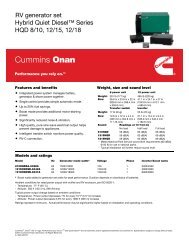Air Brake Manual
Air Brake Manual
Air Brake Manual
Create successful ePaper yourself
Turn your PDF publications into a flip-book with our unique Google optimized e-Paper software.
Section One of this manual has explained that it is<br />
possible to gain a mechanical advantage through<br />
the use of levers and that air under pressure can be<br />
used to gain a mechanical advantage. Section Two<br />
will explain how air under pressure can be used to<br />
operate the air brakes of a vehicle.<br />
Piping illustrations have been kept simple in order to<br />
be easily understood. The piping arrangements<br />
found on vehicles in actual use on the highway<br />
might differ somewhat from the illustrations in this<br />
manual.<br />
The Components of an <strong>Air</strong> <strong>Brake</strong> System<br />
A basic air brake system capable of stopping a<br />
vehicle has five main components:<br />
1. A compressor to pump air with a governor to<br />
control it.<br />
2. A reservoir or tank to store the compressed air.<br />
3. A foot valve to regulate the flow of compressed<br />
air from the reservoir when it is needed for<br />
braking.<br />
4. <strong>Brake</strong> chambers and slack adjusters to transfer<br />
the force exerted by the compressed air to<br />
mechanical linkages.<br />
5. <strong>Brake</strong> linings and drums or rotors to create the<br />
friction required to stop the wheels.<br />
It is necessary to understand how each of these<br />
components work before studying their functions in<br />
the air brake system.<br />
Governor<br />
Compressor and Governor<br />
Compressed air is used to transmit force in an air<br />
brake system. The source of the compressed air is a<br />
compressor (1). A compressor is designed to pump air<br />
into a reservoir which results in pressurized air.<br />
The compressor is driven by the vehicle’s engine, either<br />
by belts and pulleys or shafts and gears. In vehicles<br />
where the compressor is driven by belts, they should be<br />
checked regularly for cracks and tension. Also, check the<br />
compressor for broken mounting brackets or loose bolts.<br />
The compressor is in constant drive with the engine.<br />
Whenever the engine is running, so is the compressor.<br />
When pressure in the system is adequate, anywhere<br />
from a low of 80 psi to a high of 135 psi it is not necessary<br />
for the compressor to pump air. A governor (2) controls the<br />
minimum and maximum air pressure in the system by<br />
controlling when the compressor pumps air. This is<br />
known as the “loading” or “unloading” stage. Most<br />
compressors have two cylinders similar to an engine’s<br />
cylinders. When the system pressure reaches its<br />
maximum, which is between 115 and 135 psi, the<br />
governor places the compressor in the “unloading”<br />
stage.<br />
The compressor must be able to build reservoir air<br />
pressure from 50 to 90 psi within three minutes. If unable<br />
to do so the compressor requires servicing. A<br />
compressor may not be able to build air pressure from 50<br />
to 90 psi within three minutes if the air filter is plugged or<br />
if the belt is slipping. If these were not at fault the<br />
compressor could be faulty.<br />
Pressure setting spring<br />
Exhaust port<br />
Exhaust port<br />
Unload port<br />
Unload port<br />
Reservoir port<br />
Reservoir port<br />
12




